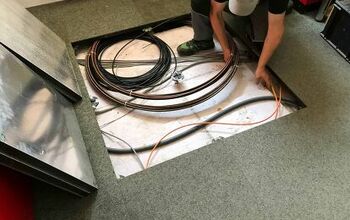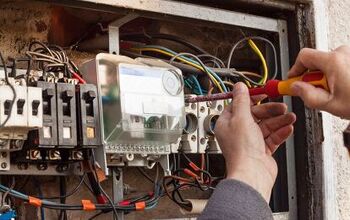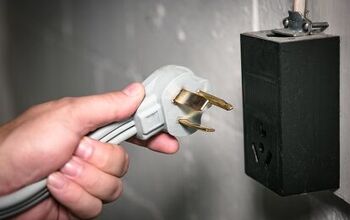What Size Wire For 200 Amp Service Underground?

If you are running an underground 200 amp service, then you may be wondering what size wire to use in your installation. We’re going to answer that question for you, however, keep in mind that you may need a permit and that a professional should do the installation.
For a 3″ conduit, a #4/0 AWG aluminum/copper-clad wire or a #2/0 AWG copper wire is needed for a 200 amp electrical service. In most states, this is not a DIY project as hiring an electrician and obtaining certain permits is required in order to have your wire installed according to your local electrical codes.
Electrical work can be a daunting task if you do not know all of the requirements, codes, and permit rules. You should start by finding out what codes and permits are needed in your area.
This information is provided as our informed opinion and does not constitute actual advice from a licensed professional.
Wire Size for 200 Amp Service
Inside a 3′′ conduit, a 200 amp electrical service requires #2/0 AWG copper wire or #4/0 AWG aluminum or copper-clad wire.
A 200 amp electrical service is not a do-it-yourself project. It frequently necessitates obtaining a permit and having a skilled electrician install it according to local electrical codes.
However, you can always check with your local authorities to see what exactly is required for your region. The table below shows the size, voltage drop, and length of the wiring:
Service/Feeder Rating (Amperes) | Copper-Clad Aluminum/Aluminum Wire (AWG or kcmil) | Copper Wire (AWG or kcmil) |
100 | 4 | 2 |
110 | 3 | 1 |
125 | 2 | 1/0 |
150 | 1 | 2/0 |
175 | 1/0 | 3/0 |
200 | 2/0 | 4/0 |
225 | 3/0 | 250 |
250 | 4/0 | 300 |
300 | 250 | 350 |
400 | 400 | 600 |
Video: What Size Wire for Your Electrical Panel
Using Copper Conductors
We suggest using copper conductors if it fits into your budget. Copper is better than aluminum for many reasons. It has been the most widely used type of wire for 200 years and holds up well over time.
If your home has a large load capacity, then using copper will help make sure that everything that your house runs, will hold up to the 200 amp service you are installing. If you are worried about the copper wire turning black, don’t be. It is natural for copper wires to become discolored through the process of oxidation.
Reasons to Use Copper Wiring
When it comes to wiring, copper is favored. Copper wire has a number of advantages, including:
- Copper can reach farther. Copper’s strong conductive qualities and heat resistance allow it to be used across longer distances.
- Copper wire is more heat resistant than aluminum wire because of its conductive qualities. Because copper wire does not expand and contract like aluminum, the wire connections on lugs stay tight.
- Copper is more flexible. Because copper is extremely conductive, the wire strands are thinner, allowing the wire to bend more easily without breaking.
- Copper wire is second only to silver in terms of electric conductivity. Copper has a better electrical load carrying capacity, needing less insulation and a smaller wire gauge. For the same conductivity, copper wiring is about half the size of aluminum wiring.
- Corrosion Resistant. Copper is a corrosion-resistant metal. Patina, a tarnish that forms on copper due to oxidation, has no effect on its conductivity.
Using Aluminum or Copper-Clad Aluminum
Aluminum will work if you are on a budget. It is cheaper than copper, but does not conduct electricity as well, and could be less than ideal if your home has a large load capacity. For this reason, if you are using aluminum, we suggest copper-clad aluminum.
It helps the aluminum conduct better and keeps it from corroding as much. You will spend a little bit more, but you will be happy that you did.
Aluminum expands and contracts with heat, this can cause the wiring to loosen over time, and could eventually cause a fire hazard.
Why Use Aluminum or Copper-Clad Aluminum Wire?
For a variety of reasons, aluminum wire is preferred for service entry wire, including:
- Faster Installation. Because aluminum is lightweight and flexible, it can be installed more quickly than copper, saving time and money.
- Aluminum is lightweight. Despite the wire gauge being near twice the size of copper, aluminum is lightweight and relatively flexible, making it easier to work with.
- Aluminum wire is preferred since it is less expensive. When compared to copper wire, aluminum wiring is less expensive to manufacture. Copper-clad aluminum wiring is recommended, however, it is more expensive than aluminum wiring.
- It is more suitable for residential settings. Aluminum service wiring is made out of smaller solid aluminum strands rather than a single solid wire, making it suitable for usage in residential settings.
How Many Feet of Wire Are You Running?
You will also need to consider how many feet of wire you will be running. This can be a deciding factor, in whether or not you will use copper or aluminum wire.
While both wires are rated to be used with 200 amp service, copper can be used at longer lengths. This is because it conducts better and does not expand and contract like aluminum.
With long distances, aluminum can interfere with the flow of electricity. There are precautions you can take if you are going with aluminum, such as using copper-clad aluminum and using special copper fittings on the ends of the aluminum wire.
The Distance the Service Wire is Running
Wire made of aluminum and copper is rated for 200 amps of service. The aluminum gauge, on the other hand, will be higher due to its lower conductivity and heat resistance. Copper wire can be used over a greater distance.
One thing you should consider is how long the service wire will go from the meter to the electrical panel when you determine the wire size. The greatest voltage drop is 3%. The voltage drop will often determine whether copper or aluminum wire can be used, as well as the gauge required.
Distances may differ depending on where you are:
Service Wire Size | Distance (Approximate) to Maintain 3% Voltage Drop |
Aluminum #4/0 Wire | 50 feet |
Aluminum 300kcmil | 100 feet |
Copper #2/0 Wire | 50 feet |
Copper #3/0 Wire | 100 feet |
Copper #4/0 Wire | 150 feet |
How Load Impacts Voltage Drop
As the load on a circuit increases, the voltage drop increases, and overload on a circuit will contribute to excessive voltage drop.
Put simply, if you have too many loads on a circuit and surpass the standard 80 percent safe capacity, you will be adding superfluous voltage drop. To avoid this, maintain the total load on the circuit to 80 percent or less of the total capacity.
Sizing Conductors
It is recommended by the National Electrical Code (NEC) to use a maximum voltage drop of 3 percent for individual household circuits, or branch circuits. This number is also a good guide for sizing the conductors for an underground run.
Check the Codes
The codes can vary by state, or location, so always make sure that you check your local codes before having any electrical work done. The codes will let you know what AWG wire you should use, for any amount of amps.
While the wire sizes we have provided should be good enough to run your 200 amp service, there may be extra rules that apply to use them in your location.
If you are unsure of how to check the codes, or what they mean, make sure that you have a professional making the final decision. This can save you time and money, by avoiding mistakes early on.
Do You Need a Permit?
You may need a permit to install a 200 amp service. The last thing you want to do is get your operation shut down for not using the correct permits. Most large electrical operations, such as a 200 amp service, require a permit.
You will need a licensed professional to pull your permit. We suggest always using a professional when doing something of this magnitude. Electric work can be dangerous, even if you know a little bit about it. An underground 200 amp service has a lot of power, parts, and work that must be done properly.
Cost to Install 200 Amp Electrical Service
The cost of installing a 200 amp service will vary depending on your region and local material costs. The cost will also be decided by the amount of work required. A 200 amp electrical service usually entails the installation of a 200 amp service wire, conduit, meter base, and a 200 amp electric panel.
According to several electricians that we reached out to for quotes, a complete 200 amp electric installation will cost between $1,600 and $6,400, with a median cost of around $3,800, and will include the following:
- 200-amp Service Wire Costs: Between $1000 and $1500 on average, with a median of $1250.
- The average cost of a 200 amp service panel: Between $500 and $4000, with a typical cost of $2000.
- The average cost of a 200 amp meter base: Between $100 and $650, with a typical cost of $450.
Tips for Installing a 200 Amp Service Underground
Here are a few tips that will help determine what is needed for installing a 200 amp service. These are best practices that you should try to follow.
- Use a licensed professional. Do not cut corners when it comes to electrical work of this size, always use a professional. Performing electrical work is incredibly dangerous and should only be done by a certified expert.
- You will need an inspector for a 200 amp service. Since this is a big operation, you will have to have a permit and an inspector.
- Never take chances with safety. Do not perform any of this work if you are not a licensed professional, this guide is meant to teach you only what is involved.
- Use special fixtures with aluminum. If you are using aluminum wire, consider using special copper fixtures that are pigtailed onto the ends of the aluminum.
As always, working with electricity requires special caution. It is crucial that you NEVER attempt any sort of electrical work without the necessary experience.
Follow the above best practices, and you will be well underway to getting your 200 amp service, with the correct wiring.
Related Questions
Does underground wire need to be in conduit?
Only direct burial cable can be used underground without conduit. In most cases, you will use a conduit in your underground electric operation. Even with direct burial cable, you will need to use a conduit where it comes up out of the ground and into the box.

I'm a writer that is passionate about home improvements, remodeling, and renovating. I enjoy learning new skills and techniques and sharing them with others.
More by Chad Kilpatrick













![10 Best Zero Turn Mowers – [2022 Reviews & Ultimate Buyer's Guide]](https://cdn-fastly.upgradedhome.com/media/2023/07/31/9070522/10-best-zero-turn-mowers-2022-reviews-ultimate-buyer-s-guide.jpg?size=350x220)













